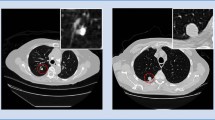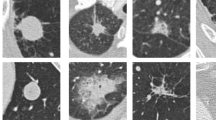Abstract
Numerous lung nodule candidates can be produced through an automated lung nodule detection system. Classifying these candidates to reduce false positives is an important step in the detection process. The objective during this paper is to predict real nodules from a large number of pulmonary nodule candidates. Facing the challenge of the classification task, we propose a novel 3D convolution neural network (CNN) to reduce false positives in lung nodule detection. The novel 3D CNN includes embedded multiple branches in its structure. Each branch processes a feature map from a layer with different depths. All of these branches are cascaded at their ends; thus, features from different depth layers are combined to predict the categories of candidates. The proposed method obtains a competitive score in lung nodule candidate classification on LUNA16 dataset with an accuracy of 0.9783, a sensitivity of 0.8771, a precision of 0.9426, and a specificity of 0.9925. Moreover, a good performance on the competition performance metric (CPM) is also obtained with a score of 0.830. As a 3D CNN, the proposed model can learn complete and three-dimensional discriminative information about nodules and non-nodules to avoid some misidentification problems caused due to lack of spatial correlation information extracted from traditional methods or 2D networks. As an embedded multi-branch structure, the model is also more effective in recognizing the nodules of various shapes and sizes. As a result, the proposed method gains a competitive score on the false positive reduction in lung nodule detection and can be used as a reference for classifying nodule candidates.











Similar content being viewed by others
References
Demir Ö, Yılmaz ÇA: Computer-aided detection of lung nodules using outer surface features. Biomed Mater Eng 26(s1):S1213–S1222, 2015
Teramoto A, Fujita H, Yamamuro O, Tamaki T: Automated detection of pulmonary nodules in PET/CT images: Ensemble false-positive reduction using a convolutional neural network technique. Med Phys 43(6):2821–2827, 2016
Setio AAA, Ciompi F, Litjens G, Gerke P, Jacobs C, van Riel S, Wille MW, Naqibullah M, Sanchez C, van Ginneken B: Pulmonary nodule detection in CT images: false positive reduction using multi-view convolutional networks. IEEE Trans Med Imaging,2016. https://doi.org/10.1109/TMI.2016.2536809
Setio AAA et al.: Validation, comparison, and combination of algorithms for automatic detection of pulmonary nodules in computed tomography images: the LUNA16 challenge. Med Image Anal 42:1–13, 2017
Le L, Devarakota P, Vikal S et al.: Computer Aided Diagnosis Using Multilevel Image Features on Large-Scale Evaluation. Lect Notes Comput Sci:161–174, 2013
Aggarwal P, Vig R, Sardana HK: Patient-Wise Versus Nodule-Wise Classification of Annotated Pulmonary Nodules using Pathologically Confirmed Cases. J Comput 8(9), 2013
Jacobs C, van Rikxoort EM, Twellmann T, Scholten ET, de Jong PA, Kuhnigk JM, Oudkerk M, de Koning HJ, Prokop M, Schaefer-Prokop C, van Ginneken B: Automatic detection of subsolid pulmonary nodules in thoracic computed tomography images. Med Image Anal 18:374–384, 2014
Setio AAA, Jacobs C, Gelderblom J, van Ginneken B: Automatic detection of large pulmonary solid nodules in thoracic CT images. Med Phys 42(10):5642–5653, 2015. https://doi.org/10.1118/1.4929562
Zagoruyko S, Komodakis N: Wide residual networks. arXiv preprint arXiv:arXiv:1605.07146, 2016
Anirudh R: Lung nodule detection using 3D convolutional neural networks trained on weakly labeled data[C]//. SPIE Medical Imaging:978532, 2016
Huang X, Shan J, Vaidya V: Lung nodule detection in CT using 3D convolutional neural networks[C]// IEEE, International Symposium on Biomedical Imaging. IEEE, 2017
Dou Q, Chen H, Yu L et al.: Multilevel contextual 3-D CNNs for false positive reduction in pulmonary nodule detection. IEEE Trans Biomed Eng 64(7):1558–1567, 2016
Ioffe S, Szegedy C: Batch Normalization: Accelerating Deep Network Training by Reducing Internal Covariate Shift. 2015
Santurkar S, Tsipras D, Ilyas A, et al: How Does Batch Normalization Help Optimization?. 2018
Armato III, Samuel G, McLennan G, Bidaut L, McNitt-Gray MF, Meyer CR, Reeves AP et al.: Data From LIDC-IDRI. Cancer Imaging Arch, 2015. https://doi.org/10.7937/K9/TCIA.2015.LO9QL9SX
Armato, III SG, McLennan G, Bidaut L, McNitt-Gray MF, Meyer CR, Reeves AP, Zhao B, Aberle DR, Henschke CI, Hoffman EA, Kazerooni EA, MacMahon H, van Beek EJR, Yankelevitz D et al.: The Lung Image Database Consortium (LIDC) and Image Database Resource Initiative (IDRI): A completed reference database of lung nodules on CT scans. Med Phys 38:915–931, 2011
Eman M, Nourhan Z, Mahmoud F: Automatic Classification of Normal and Cancer Lung CT Images Using Multiscale AM-FM Features. Int J Biomed Imaging 2015:1–7, 2015
Murphy K, van Ginneken B, Schilham AMR, de Hoop BJ, Gietema HA, Prokop M: A large scale evaluation of automatic pulmonary nodule detection in chest CT using local image features and k-nearest-neighbour classification. Med Image Anal 13:757–770, 2009
Shen W, Zhou M, Yang F, Yu D, Dong D, Yang C et al.: Multi-crop Convolutional Neural Networks for lung nodule malignancy suspiciousness classification. Pattern Recogn 61:663–673, 2017
Zhu W, et al: Deep lung: 3D deep convolutional nets for automated pulmonary nodule detection and classification, Arxiv 2017 [online]. Avaiable: arXiv: 1709.5538
Shen W, Zhou M, Yang F, Yang C, Tian J: Multi-scale Convolutional Neural Networks for Lung Nodule Classification. Inf Process Med Imaging 24:588–599, 2015
Yan X, Pang J, Qi H, Zhu Y, Bai C, Geng X, Liu M, Terzopoulos D, Ding X: Classification of lung nodule malignancy risk on computed tomography images using convolutional neural network: A comparison between 2d and 3d strategies. In ACCV, 2016
Farahani FV, Ahmadi A, Zarandi MHF: Lung nodule diagnosis from CT images based on ensemble learning[C]// Computational Intelligence in Bioinformatics & Computational Biology. IEEE, 2015
van Ginneken B, Armato SG, de Hoop B, van de Vorst S, Duindam T, Niemeijer M, Murphy K, Schilham AMR, Retico A, Fantacci ME, Camarlinghi N, Bagagli F, Gori I, Hara T, Fujita H, Gargano G, Belloti R, Carlo FD, Megna R, Tangaro S, Bolanos L, Cerello P, Cheran SC, Torres EL, Prokop M: Comparing and combining algorithms for computeraided detection of pulmonary nodules in computed tomography scans: the ANODE09 study. Med Image, 2010
Acknowledgments
The authors would like to thank the LUNA16 challenge organizers for providing the dataset and evaluation software.
Funding
This work was supported by the National Natural Science Foundation of China (NSFC) under Project 61471123 and the Research Foundation of Education Bureau of Hunan Province of China under Project 13C829.
Author information
Authors and Affiliations
Corresponding author
Additional information
Publisher’s Note
Springer Nature remains neutral with regard to jurisdictional claims in published maps and institutional affiliations.
Rights and permissions
About this article
Cite this article
Zuo, W., Zhou, F. & He, Y. An Embedded Multi-branch 3D Convolution Neural Network for False Positive Reduction in Lung Nodule Detection. J Digit Imaging 33, 846–857 (2020). https://doi.org/10.1007/s10278-020-00326-0
Published:
Issue Date:
DOI: https://doi.org/10.1007/s10278-020-00326-0




